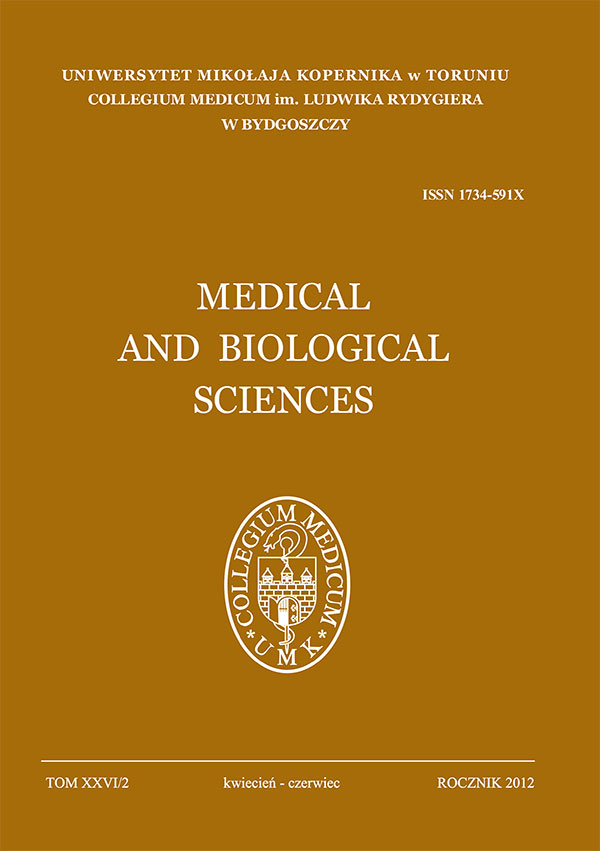BEZOBJAWOWE ZAKAŻENIE SIATKI CHIRURGICZNEJ – OPIS PRZYPADKU
DOI:
https://doi.org/10.12775/4059Słowa kluczowe
przepuklina, siatka chirurgiczna, biofilm, TTCAbstrakt
Zakażenie obejmujące implantat jest jednym z najpoważniejszych powikłań towarzyszących stosowaniu biomateriałów w chirurgii przepuklin. Zakażenie implantatu może mieć różny przebieg kliniczny. W pracy przedstawiono przypadek bezobjawowego zakażenia siatki chirurgicznej zastosowanej do zaopatrzenia przepukliny okołopępkowej. Zakażenie zostało rozpoznane przypadkowo podczas operacji z powodu nawrotu przepukliny. Badania metodą jakościową z użyciem chlorku 2,3,5-trójfenylotetrazoliowego (TTC), metodą ilościową oraz z użyciem skaningowego mikroskopu elektronowego wykazały obecność biofilmu bakteryjnego na powierzchni implantatu zastosowanego do pierwotnego zaopatrzenia przepukliny. Jego obecność na powierzchni implantatu uchroniła drobnoustroje przez działaniem układu odpornościowego pacjenta i była odpowiedzialna za bezobjawowy przebieg zakażenia biomateriału. Zdaniem autorów wszystkie implantaty usuwane podczas operacji z powodu nawrotu przepukliny należy poddać badaniu mikrobiologicznemu, nawet gdy nie stwierdza się makroskopowych cech zakażenia. Do badań diagnostycznych powinna zostać włączona metoda redukcji TTC, co pozwala ograniczyć liczbę wyników fałszywie ujemnych.Bibliografia
Tolino MJ, Tripoloni DE, Ratto R et al. Infections associated with prosthetic repairs of abdominal wall hernias: pathology, management and results. Hernia 2009; 13: 631-637, DOI: http://dx.doi.org/10.1007/s10029-009-0541-y
Bryers JD. Medical biofilms. Biotechnol Bioeng 2008; 100: 1-18, DOI: http://dx.doi.org/10.1002/bit.21838
Delikoukos S, Tzovaras G, Liakou P et al. Late-onset deep mesh infection after inguinal hernia repair. Hernia 2007; 11: 15-17, DOI: http://dx.doi.org/10.1007/s10029-006-0131-1
Sohail MR, Smilack JD. Hernia repair mesh-associated Mycobacterium goodii 42: 2858-2860, http://www.ncbi.nlm.nih.gov/pubmed/15184492
Due SS, Billesbølle P, Hansen MB. Osteomyelitis. A rare and serious complication of inguinal hernia surgery. Ugeskr Laeger 2001; 163: 3230-3231.
Gallimore B, Gagnon RF, Subang R et al. Natural history of chronic infection in a mouse model. J Infect Dis 1991; 164: 1220- 1223.
Hryniewicz W, Gniadkowski M, Łuczak-Kadłubowska A et al. Recommendations for susceptibility testing to antimicrobial agents of selected bacterial species 2006. Changes in text 2007 (in Polish). National Reference Center on Microbial Drug Susceptibility.
Performance Standards for antimicrobial susceptibility testing; nineteenth informational supplement, Vol. 29, No. 3 (2009).
Tamhankar AP, Ravi K, Everitt NJ. Vacuum assisted closure therapy in the treatment of mesh infection after hernia repair. Surgeon 2009; 7:316-318, DOI: http://dx.doi.org/10.1016/S1479-666X(09)80010-3
Gomzalez R, Fugate K, McClusky D et al. Relationship between tissue ingrowth and mesh contraction. World J Surg 2005; 29: 1038-1043, DOI: http://dx.doi.org/10.1007/s00268-005-7786-0
Mamy L, Letouzey V, Lavigne JP et al. Correlation between shrinkage and infection of implanted synthetic meshes using an animal model of mesh infection. Int Urogynecol J Pelvic Floor Dysfunct 2011; 22: 47-52. DOI: http://dx.doi.org/10.1007/s00192-010-1245-7, http://gateway.webofknowledge.com/gateway/Gateway.cgi?GWVersion=2&SrcApp=PARTNER_APP&SrcAuth=LinksAMR&KeyUT=000286105500008&DestLinkType=FullRecord&DestApp=ALL_WOS&UsrCustomerID=b7bc2757938ac7a7a821505f8243d9f3
Subbiandoss G, Grijpma DW, van der Mei HC et al. Microbial biofilm growth versus tissue integration on biomaterials with different wettabilities and a polymerbrush coating. J Biomed Mater Res A 2010; 94: 533-538. http://gateway.webofknowledge.com/gateway/Gateway.cgi?GWVersion=2&SrcApp=PARTNER_APP&SrcAuth=LinksAMR&KeyUT=000279482600023&DestLinkType=FullRecord&DestApp=ALL_WOS&UsrCustomerID=b7bc2757938ac7a7a821505f8243d9f3
Bellón JM, N G-Honduvilla, Jurado F et al. J In vitro interaction of bacteria with polypropylene/ePTFE prostheses. Biomaterials 2001; 22:2021-2024. DOI: http://dx.doi.org/10.1016/S0142-9612(00)00390-2
Edds EM, Bergamini TM, Brittian KR. Bacterial components inhibit fibroblast proliferation ASAIO J 2000; 46:33-37. DOI: http://dx.doi.org/10.1097/00002480-200001000-00011
Antonopoulos IM, Nahas WC, Mazzucchi E et al. Is polypropylene mesh safe and effective for repairing infected incisional hernia in renal transplant recipients? Urology 2005; 66: 874-877. DOI: http://dx.doi.org/10.1016/j.urology.2005.04.072
Diaz JJ, Conquest AM, Ferzoco SJ et al. Multiinstitutional experience using human acellular dermal matrix for ventral hernia repair in a compromised surgical field. Arch Surg 2009; 144: 209-15. http://gateway.webofknowledge.com/gateway/Gateway.cgi?GWVersion=2&SrcApp=PARTNER_APP&SrcAuth=LinksAMR&KeyUT=000264218700003&DestLinkType=FullRecord&DestApp=ALL_WOS&UsrCustomerID=b7bc2757938ac7a7a821505f8243d9f3
Broekhuizen CA, de Boer L, Schipper K et al. Periimplant tissue is an important niche for infection in mice. Infect Immun 2007; 75: 1129-36.
Broekhuizen CA, de Boer L, Schipper K et al. Staphylococcus epidermidis implants but persists in peri-implant tissue in mice despite rifampicin/vancomycin treatment. J Biomed Mater Res A 2008; 85: 498-505.
Yassien M, Khardori N. Interaction between biofilms formed by Diagn Microbiol Infect Dis 2001; 40: 79-89.
Jałoza D, Juda M, Malm A et al. The qualitative and quantitative detection of biofilm formation biomaterials. Sepsis, 2009; 2: 143-146.
Opublikowane
Jak cytować
Numer
Dział
Statystyki
Liczba wyświetleń i pobrań: 0
Liczba cytowań: 0



